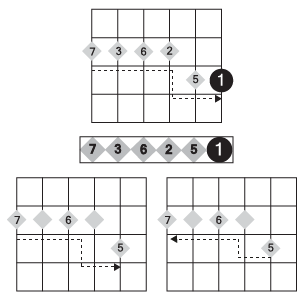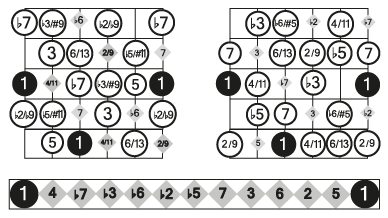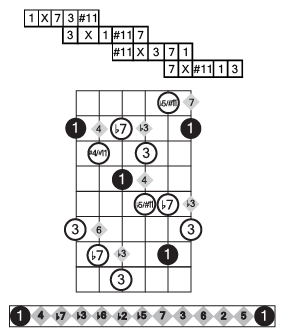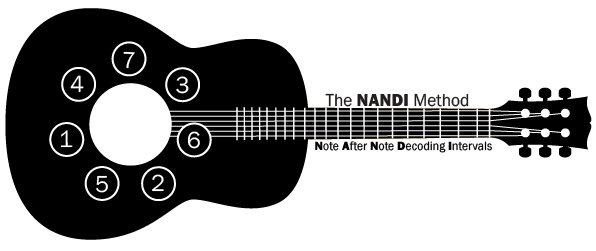Hello and welcome to thenandimethod.com! My name is Nan and I would like to present my book “GUITAR INTERVALS UNLEASHED”.
Why are you writing this book?
While there are ear training methods to recognize intervals aurally, training methods to help you visualize intervals on the guitar are few and far between. Most books on guitar instruction devote very little space, if any, to the study of intervals even though it is often acknowledged that intervals are the building blocks of scales and chords. In addition, intervals play an integral role in the larger context of chord voicings. A book that covers all aspects of this subject is desperately needed.
The ultimate goal of every guitarist should be to be able to see the guitar as interval numbers instead of just notes. Whether one wants to locate an interval on an adjacent/non-adjacent string, or freely improvise across all areas of the fretboard, the importance of visualizing interval numbers on the fretboard cannot be stressed enough.
To remedy this situation, I have developed a novel method of interval training called the NANDI method, which is an acronym for Note After Note Decoding Intervals. It is a comprehensive method aimed at helping guitarists of all skill levels visualize the interval fretboard. The knowledge that you will acquire from reading this book will provide a solid foundation for everything related to naming, locating, decoding, identifying, analyzing, deriving and inverting guitar intervals. This method is meant to be practiced on paper, with the acquired knowledge then being applied to your playing.
What is your book about?
DISCLAIMER!
This is not a book about how to play guitar. It is a visual learning method offering novel strategies to decipher the interval matrix using elaborate fret diagrams. It presents a revolutionary approach to tackle the difficult task of identifying and locating intervals. This book seeks to decode the complex arrangement of the interval fretboard by exposing layer after layer of interval and inversion patterns that have gone unnoticed up until now. The ultimate goal is to help the student visualize every interval on every string set without memorization.
What is the foundation for this method?
The NANDI method sets out to prove that it is possible to master the interval fretboard without relying on memorized interval and chord shapes. To decode the interval matrix on the guitar, the first step is to draw a correlation between open note relationships and the spatial arrangement of notes on the fretboard. Given that the guitar is tuned mostly in fourths, it can be stated that the fourth interval pattern is undoubtedly the most conspicuous pattern that dominates the guitar’s interval structure. It is found to run across six strings and two successive frets from the lowest string to the highest string in an almost horizontal line.
With its constant presence on the same fret of each adjacent string (except the B string), using fourths as reference points makes perfect sense as a starting point when attempting to locate intervals. Upon further analysis of the fourth pattern, three other interval patterns (seconds, sevenths, and fifths) are revealed. As interval patterns are uncovered, the fretboard’s interval matrix is further demystified, providing the player with an unlimited number of pathways through which they can navigate the fretboard.


How is this method implemented?
The only interval patterns that are covered in a majority of books are counting up or down from a note in half-steps along a string to derive a series of chromatic intervals or counting in half and whole-steps along the same string to derive major and minor scale intervals. Recognizing and utilizing the fourth, fifth, second and seventh interval patterns detailed in this book to plot intervals and their inversions in all areas of the guitar neck is the key to unlocking the secrets of the interval fretboard.
The benefits of applying various strategies will become apparent as you progress through the chapters which are organized in order of relevancy. Previously unnoticed intervallic relationships will now become relevant as points of reference to instantly identify intervals, thereby putting you on a fast track to having a commanding knowledge of this integral aspect of the guitar.<
What is the logic behind this method?
The common belief that the guitar is an impenetrable matrix of intervals can be disproved as you start to implement the NANDI method. As you begin an in-depth analysis of each of the four naturally occurring interval patterns on the guitar, you begin to see the fretboard as a cohesive arrangement of patterns.
Although most chords are constructed by stacking thirds, it should not be assumed that you can most easily apply thirds when locating chord tones given the overwhelming presence of fourths. If you can adapt your thinking to align with the existing interval setup on the guitar, you will arrive at the obvious conclusion that the best approach to locate the higher note of any given interval is to use a fourth as a reference point. Since fifths are inversions of fourths, the reverse is true when locating an interval situated on a string that is lower than that of the root. In addition, the intervallic relationship between open notes on a chosen string set could also be used as a reference to quickly locate intervals around CAGED roots located on string pairs A-B (C shape), A-G (A shape), E-G (G shape), E-D (E shape), and D-B (D shape).


Who is the audience for your book?

Beginner / Advanced Beginner:
Some ways of teaching basic music theory which are presented from a fresh new perspective include: recalling note names and interval numbers running horizontally across strings by applying the circle of Fourths/Fifths, learning interval naming conventions using natural notes and intervals from the C major scale, using mnemonic devices to recall the names of letter notes as well as the twelve interval numbers, locating and naming natural notes on the guitar horizontally across frets instead of vertically along the length of a string; transitioning effortlessly between natural and accidental notes across strings, deriving sharps and flats in a key and arriving at notes in a major scale without referring to the major scale itself, altering natural note interval qualities with the addition of a sharp or flat and identifying intervals involving accidentals without counting scale steps (i.e. referencing the half-step, whole-step formula), assigning the correct spelling to enharmonic notes in an octave, using simple algorithms or the existing intervallic relationship between the two involved strings as a reference to derive an interval’s exact fret location. All the shortcuts described above are meant to teach basics in a practical way to be mastered in a shorter period of time than by using traditional methods.
The reader will observe that this book refrains from using musical notation. The objective is to make learning accessible to students without any music training. Most books show intervals and notes as circles or dots which makes learning difficult. The brain processes visuals much faster than text. In this book there are dozens of fret and neck diagrams with clearly labeled notes and intervals to make the process of visualization easy for the student. The merits of visual learning cannot be underestimated or refuted.
Every possible interval existing between any two letter notes (or interval numbers) on every string set is explored. Ways to alter intervals with natural notes and natural numbers are explained in great detail in a simple and straight forward manner which can be easily understood by students at any level and in any age group.
Chapters in this book are organized in a methodical and logical fashion, which enables the reader to appropriately progress at his or her own pace. Best of all, there is not an endless number of shapes to memorize.
Intermediate Student:
The basics described above can be used as supplemental information for anyone who falls into the intermediate category. There is always a reward in knowing more than one way to do something through expanding your knowledge. Using the tips, tricks and shortcuts, which are abundantly employed in this book, the intermediate student has much to gain and nothing to lose.
Guitarists at this level tend to identify an interval’s location by using known letter note locations as references. Figuring out the identity or location of an interval using naturally occurring fourths or the intervallic relationships on string pairs as reference points would be a more practical way.
One chapter describes how to refer to the pitch distance between the open notes of a chosen string set to locate interval numbers and letter notes on those corresponding strings. Additionally, the chapter called “Interval Architecture” illustrates the steps to mathematically derive an interval’s exact location by using simple algorithms. If you want to memorize all note locations on the guitar, there is a chapter which explains how to derive the fret location of a note on a specific string, first by treating the open note as the root, and then by calculating the desired note’s distance in half-steps from the open note (i.e. the assumed root). Since an interval’s pitch distance in half-steps equals the same number of frets on the guitar, the student can practice all the note locations on each string by studying the provided tables.
Advanced Student:
Being able to see the fretboard as a network of interval numbers is a universal challenge faced by novices and experts alike. Without a proper foundation in visual interval training, students dive straight into memorizing chord shapes.
The ability to hear intervals and being technically adept at playing the guitar are important skills to possess as an advanced guitarist. Equally important is the ability to visualize intervals when playing chords, scales, modes and arpeggios.
After years of learning the guitar by rote, it is understandable that getting out of one’s comfort zone and approaching the fretboard from a different perspective may feel awkward at first. Before long, however, the efficacy of this method will soon be realized by even an advanced player. Additionally, if an advanced player has memorized every interval and chord shape there is, they are probably giving guitar lessons or will be inclined to teach in the future. By teaching a method that is both logical and verifiable you will be saving students precious time and the agony of memorization.
By implementing the concepts discussed in this book, an advanced student will have the ability to do the following: locate intervals on non-adjacent strings on the same fret or a higher/lower fret, quickly recall fret distances between the root and intervals in either direction on a chosen string set, develop the skills to visualize intervals within each voicing while playing chord progressions, locate chord tones, extensions and alterations in complex jazz voicings involving ninths, elevenths and thirteenths, effectively use interval inversions while improvising, and navigate the fretboard seamlessly while soloing.

